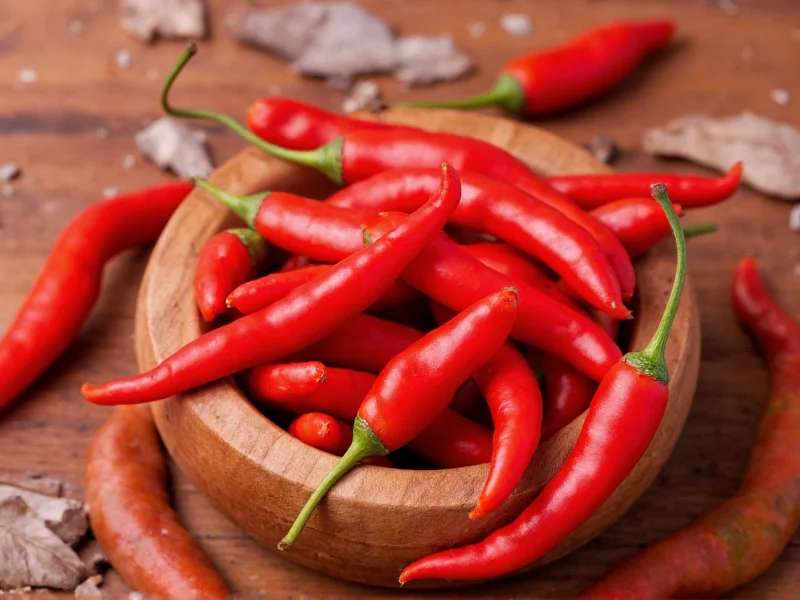Chili de arbol, known as “árbol” (tree) or “bird’s beak” chili in Mexico, delivers distinctive medium-high heat with subtle smoky, nutty notes. When you can’t find this slender, bright red dried pepper, understanding proper substitutions prevents recipe failures while maintaining authentic flavor balance.
Understanding Chili de Arbol Characteristics
Before selecting a substitute, recognize what makes chili de arbol unique. This Mexican staple measures 15,000-30,000 Scoville Heat Units (SHU)—hotter than jalapeños but milder than habaneros. Unlike many dried chilies, it retains bright, grassy notes alongside its heat, making it essential in salsas, adobos, and traditional dishes like salsa roja. The thin skin rehydrates quickly, releasing flavor without overwhelming bitterness.
Top 5 Chili de Arbol Substitutes Ranked
Not all substitutes work equally well across cooking applications. Consider these factors when choosing your replacement:
| Substitute | Heat Level (SHU) | Flavor Profile | Best For | Substitution Ratio |
|---|---|---|---|---|
| Cayenne pepper | 30,000-50,000 | Sharp, slightly smoky | Sauces, marinades, dry rubs | 1:1 (reduce by 25% for equal heat) |
| Crushed red pepper flakes | 10,000-25,000 | Variety-dependent, often mixed heat | Pasta, pizza, quick sauces | 1.5x amount (adjust for seed content) |
| Fresh serrano peppers | 10,000-25,000 | Grassy, bright, vegetal | Salsas, fresh preparations | 2x amount (finely minced) |
| Guajillo peppers (dried) | 2,500-5,000 | Fruity, berry-like, mild heat | Color-focused sauces, milder dishes | 3x amount + pinch cayenne |
| Chipotle powder | 2,500-8,000 | Smoky, earthy, sweet | Barbecue, stews, smoky profiles | 2x amount + extra heat source |
When to Choose Each Substitute
For authentic Mexican recipes: Cayenne pepper provides the closest heat match for chili de arbol substitute in traditional Mexican cooking. Though slightly hotter, its clean burn mimics arbol’s profile better than mixed-pepper flakes. Use 3/4 teaspoon cayenne for every 1 teaspoon chili de arbol powder.
For fresh applications: When your recipe calls for fresh chili de arbol (less common), serrano peppers offer comparable heat with similar grassy notes. Mince two serranos for every one fresh arbol chili. Remove seeds for closer heat matching.
For texture-sensitive dishes: Crushed red pepper flakes work well in oil-based sauces where texture matters less. Opt for Italian-style flakes with visible seeds for better heat control. Use 1.5 teaspoons flakes per 1 teaspoon chili de arbol.
Adjusting Recipes for Successful Substitution
Successful chili de arbol replacement requires more than simple measurement swaps. Consider these professional adjustments:
- Timing matters: Add substitutes later in cooking than chili de arbol to prevent flavor degradation. Cayenne loses nuance with prolonged simmering.
- Balance acidity: Arbol’s brightness often pairs with lime. When substituting milder options like guajillo, add 1/2 teaspoon lime juice per serving.
- Oil infusion technique: For dried substitutes, toast in 2 tablespoons oil for 60 seconds before adding other ingredients to maximize flavor extraction.
- Heat calibration: Always add 75% of your calculated substitute amount first, then taste before final adjustment.
Special Considerations for Specific Dishes
Salsa roja: Use cayenne pepper at 3:4 ratio with a splash of vinegar to mimic arbol’s sharpness. Avoid chipotle here as smokiness overwhelms traditional flavor.
Adobo sauce: Combine equal parts ancho and cayenne powder for complex flavor. Ancho provides body while cayenne delivers necessary heat for proper chili de arbol substitute in adobo.
Marinades: Crushed red pepper flakes work best here—their oil solubility distributes heat evenly. Soak flakes in citrus juice for 10 minutes before adding to marinade for optimal flavor release.
Storage and Preparation Tips
Maximize substitute effectiveness with proper handling. Store cayenne and red pepper flakes in airtight containers away from light—heat degrades potency within 6 months. For fresh serrano substitutes, refrigerate whole peppers up to 3 weeks. When substituting dried peppers, rehydrate in hot water for 15 minutes before use to approximate arbol’s texture.
Common Substitution Mistakes to Avoid
Cooking enthusiasts often make these errors when seeking chili de arbol replacement:
- Using generic “chili powder” (typically ancho-based blends) without adjusting for lower heat
- Substituting hotter peppers like Thai bird chilies without significant quantity reduction
- Adding substitutes too early in cooking, causing bitter notes
- Ignoring regional variations—Mexican red pepper flakes differ significantly from Italian versions
FAQ: Chili de Arbol Substitutes
Can I use paprika as a chili de arbol substitute?
Regular sweet paprika lacks sufficient heat (only 500-1,000 SHU) for proper chili de arbol substitution. Use smoked paprika mixed with cayenne (3:1 ratio) to approximate both heat and flavor. For every 1 teaspoon chili de arbol, combine 3/4 tsp smoked paprika with 1/4 tsp cayenne.
How do I substitute fresh chili de arbol when unavailable?
Fresh serrano peppers provide the closest match. Use two serranos for each fresh chili de arbol. For milder heat, remove seeds and membranes. Slice thinly crosswise for proper texture substitution in salsas and salads.
Why does my substitute make my dish bitter?
Bitterness typically occurs when substitutes are added too early in cooking or overheated. Dried chili substitutes should steep in hot liquid for 10-15 minutes rather than simmering for extended periods. Reduce cooking time by 50% compared to original chili de arbol instructions.
What’s the best mild substitute for chili de arbol?
For a milder chili de arbol substitute, use guajillo peppers blended with a pinch of cayenne. Guajillos (2,500-5,000 SHU) provide similar color and body at lower heat. Use three parts guajillo to one part cayenne to maintain flavor complexity without overwhelming heat.











 浙公网安备
33010002000092号
浙公网安备
33010002000092号 浙B2-20120091-4
浙B2-20120091-4